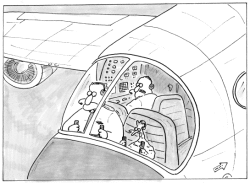WEIGHT & BALANCE
Arm (moment arm) - is the horizontal distance in inches from the reference datum line to the center of gravity of an item. The algebraic sign is plus (+) if measured aft of the datum, and minus (-) if measured forward of the datum.
Basic empty weight (GAMA) - includes the standard empty weight plus optional and special equipment that has been installed.
Center of gravity (CG) - is the point about which an airplane would balance if it were possible to suspend it at that point. It is the mass center of the airplane, or the theoretical point at which the entire weight of the airplane is assumed to be concentrated. It may be expressed in inches from the reference datum, or in percent of mean aerodynamic chord (MAC).
Center-of-gravity limits - are the specified forward and aft points within which the CG must be located during flight. These limits are indicated on pertinent airplane specifications.
Center-of-gravity range - is the distance between the forward and aft CG limits indicated on pertinent airplane specifications.
Datum (reference datum) - is an imaginary vertical plane or line from which all measurements of arm are taken. The datum is established by the manufacturer. Once the datum has been selected, all moment arms and the location of CG range are measured from this point.
Delta - is a Greek letter expressed by the symbol Δ to indicate a change of values. As an example, ΔCG indicates a change (or movement) of the CG.
Fuel load - is the expendable part of the load of the airplane. It includes only usable fuel, not fuel required to fill the lines or that which remains trapped in the tank sumps.
Licensed empty weight - is the empty weight that consists of the airframe, engine(s), unusable fuel, and undrainable oil plus standard and optional equipment as specified in the equipment list.
Maximum landing weight - is the greatest weight that an airplane normally is allowed to have at landing.
Maximum ramp weight - is the total weight of a loaded aircraft, and includes all fuel. It is greater than the takeoff weight due to the fuel that will be burned during the taxi and runup operations.
Ramp weight may also be referred to as taxi weight.
Maximum takeoff weight - is the maximum allowable weight for takeoff.
Maximum weight - is the maximum authorized weight of the aircraft and all of its equipment as specified in the Type Certificate Data Sheets (TCDS) for the aircraft.
Maximum zero fuel weight (GAMA) - is the maximum weight, exclusive of usable fuel.
Mean aerodynamic chord (MAC) - is the average distance from the leading edge to the trailing edge of the wing.
Moment - is the product of the weight of an item multiplied by its arm. Moments are expressed in pound-inches (lb-in). Total moment is the weight of the airplane multiplied by the distance between the datum and the CG.
Payload (GAMA) - is the weight of occupants, cargo, and baggage.
Standard empty weight (GAMA) - consists of the airframe, engines, and all items of operating equipment that have fixed locations and are permanently installed in the airplane; including fixed ballast, hydraulic fluid, unusable fuel, and full engine oil.

WARNING : pilot cannot legally fly an aircraft unless:
-
the aircraft is operated in accordance with the requirements of the Pilot Operating Handbook—including weight and loading limitations.
-
the load is properly disposed in the aircraft.
-
the cargo and equipment is secured to prevent shifting and the passenger exits are not blocked.

Procedure
For each station item, the weight is multiplied by the arm to establish (for each position) a moment. To determine the aircraft C of G, the total moment (all station moments added together, including the BEW moment) is divided by the total weight. The sum, in inches, provides the C of G for the aircraft and is compared with the aircraft C of G “envelope” found in the Pilot Operating Handbook to determine if it is within limits.


A computation table, such as appears above, helps simplify the calculations. In this example, the total weight (1995 lbs.) is added up to ensure it is within the permissible limit; then the total moment (175,615) is divided by the total weight to provide the centre of gravity (88.0 inches); finally, this C of G number, along with the total takeoff weight of the aircraft, is checked against graphs found in the Pilot Operating Handbook to determine if the aircraft is within permissible limits.
